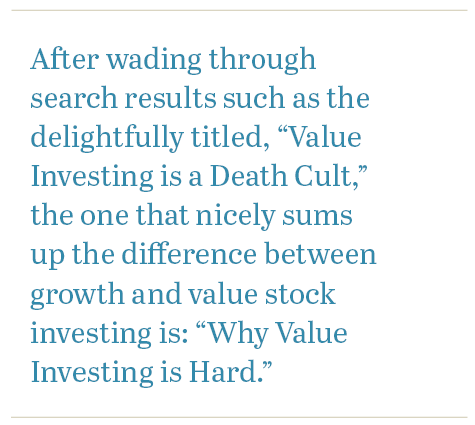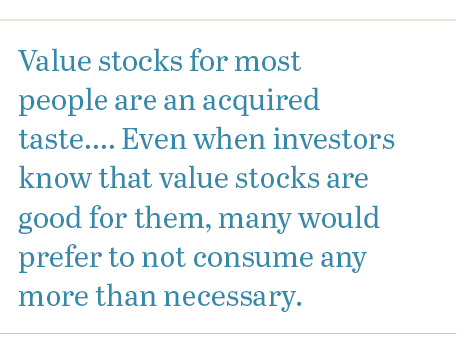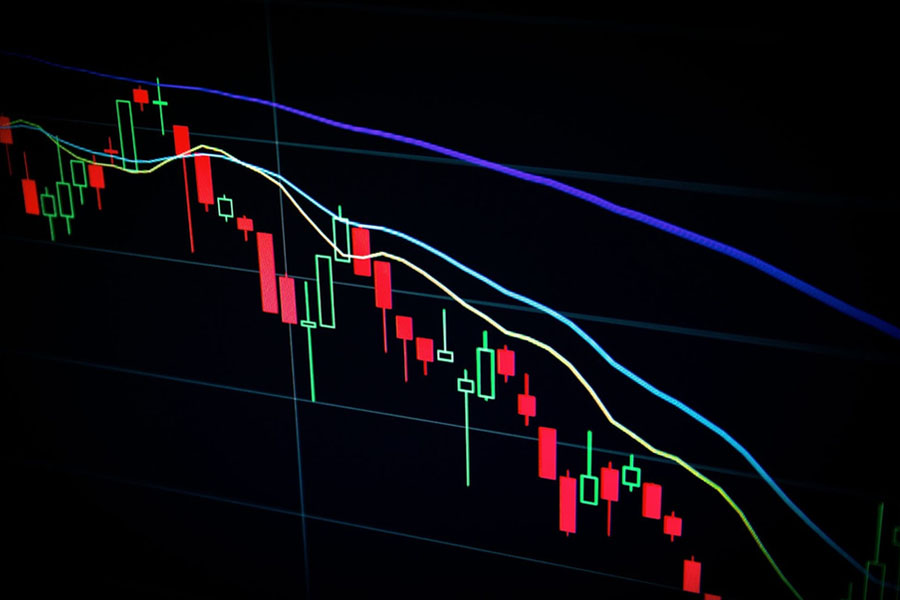Country Indices Flash Report – September 2021
Rising inflation, slowing economic growth forecasts and inklings of a 2013-like taper tantrum weighed on global equities in September. Japan, often a winner in risk-off environments, and energy exporters bucked the trend.
Busting Value Stock Myths
Thomas J. Mudge III, CFA, Director, Equity Research Investment, introduces his research related to busting six value stock investing myths. Here we dive into what creates skepticism around value stocks, and the one myth that can’t be solved.
September 30, 2021
MythBusters was a long running television show on the Discovery Channel where the plausibility of commonly held wisdom or beliefs were scrutinized to determine their validity using scientific tests and experiments. Some of the myths tested on the program were confirmed as true. Apparently you can dip your wet hand into molten lead briefly and remove it unscathed (due to the Leidenfrost effect). Other myths were viewed as plausible. If you drive a convertible car with the top down fast enough in a rainstorm, (+90 mph) you may not get wet (just imperil the safety of yourself and others). Of course, many of the myths tested turned out to be false and were busted. A goldfish’s memory actually lasts for months at a minimum, not three seconds as is widely believed. The world of finance has its share of myths as well, and many center around value stocks and value stock investing.

As long-time value investors, we see a healthy amount of skepticism. If you Google “death of value investing,” you get over 60 million hits; if you then try “death of growth investing,” there’s only about half as many (35 million).
Growth Stocks are Easy to Like
Growth stocks are like symmetrical faces or the golden ratio in art, people seem instinctively predisposed to like them. The narratives attached to growth stocks primarily emphasize the positive, with words and phrases like game changer, revolutionary, cutting edge, scalable, disruptive, next generation, and category killer. Growth companies are on average more profitable, less cyclical, and of course faster growing than value companies, and their path toward further prosperity appears clear.
In contrast, value stocks typically have one or more visible and sometimes scary problems in addition to their generally slower growth and lower profitability. Value companies often reside in less exciting and old-fashioned industries like commercial printing, food processing, healthcare facilities, and footwear. Their road to future success is often unclear or difficult to imagine. It is frequently difficult to get excited about value stocks. Perversely, it is precisely this lack of investor excitement that has made value investing lucrative historically.
Two Camps of Skeptics
The source of most value stock myths come from two different but closely related camps. The “never value” group is philosophically and/or temperamentally opposed to value investing. Another set of myths comes from the “maybe value, but not right now” camp. This group sees merit in value investing, but can usually find a reason why the timing just isn’t right.
In the minds of both groups, growth stock outperformance is the natural order of things, occasionally interrupted by abnormal or extraordinary events, but destined to resume its inevitable triumph over value in short order.
To be fair, for much of the past decade—but particularly the period of 2017 through the first three quarters of 2020—growth stocks have been the place to be. Growth stocks handily outperformed value stocks during this stretch, and the initial stages of the pandemic exacerbated the relative performance gap. As students of behavioral finance, we realize the power recent experience has on investor preferences, and it is understandable growth would be particularly popular after all that success.
The prevailing order shifted dramatically when value began massively outperforming from October of 2020 through March of 2021. But, since then, value has given back much of those relative gains and still has a long way to go to even the score.

Can value stocks return to past levels of relative success?
We believe that value stocks can, and will, catch up. In our forthcoming, full-length research piece titled, “Busting Value Stock Myths”, we examine six of the many myths regarding value stocks that resurface time and again (see Exhibit 1).
As a prelude, let’s take a moment to evaluate the one myth that is neither busted nor confirmed in Bailard’s research, as it reveals much about investors’ behavior.

This time, it’s different.
It is impossible to prove or disprove the myth that the world has changed, and that conditions are different this time. The world is always changing, though the pace of change certainly varies over time. Innovation and disruption may produce a coming golden age for growth companies, or competition, regulation, intellectual property theft, another Carrington Event (geomagnetic storm), or even plain old reversion to the mean could produce just the opposite. No one knows, but given the current relative valuation starting point between growth stocks and value stocks, “this time is different” appears to be already priced in as suggested in Exhibit 2.
“People are disturbed not by events, but by the view they take of them.”
This quote from philosopher Epictetus memorializes that the power of expectations has been recognized since at least the time of the ancient Greeks. It is as true today as it was almost 2,000 years ago that people’s (and investors’) expectations determine how, and how strongly, they react to events. Most events in life have expectations built in, and expectations have the biggest impact when actual events deviate from them, particularly in the opposite direction.
Human nature tends to lead investors toward excessive optimism, overconfidence in their predictive abilities, and an inclination toward anchoring their predictions based upon recent past trends. Given these biases, and an uncertain future, what types of stocks are likely to be cursed with high expectations, and which are blessed by having to deliver very little in order to pleasantly surprise? Perhaps history offers some clues?

As you can see in Exhibit 3, stocks where high expectations are built in—growth stocks both large and small—have underperformed value stocks over the long run.
Kale, Quinoa, and Turnips

Value stocks for most people are an acquired taste. Value investing requires going against the conventional wisdom, and being wrong about 40% of the time. No matter how many myths about value investing are “busted,” the value premium has not been arbitraged away even though it is widely recognized for the same reason that health foods do not dominate the shelves of most grocery stores. Even when investors know that value stocks are good for them, many would prefer to not consume any more than necessary. Value investors have historically been compensated with higher returns for exposing their portfolios to the greater discomfort and uncertainty associated with value stocks, but that is a price that not everyone is willing to pay.
We can also argue that growth and value are both somewhat artificial constructs. By definition, even a growth manager is seeking undervalued companies within their universe. No matter what space you’re investing in, having a perception that differs from the broad market is the only way to win. Most importantly, this debate emphasizes the critical role that active management plays for growth and value investing alike. Testing the validity of theories and rumors to bust the myth and expose the truth is not only entertaining and insightful, but can aid in the effort to actively manage portfolios, their risk, and ultimately their performance.
Closing Brief - Bailard’s View on the Economy: Supply-Chained
This quarter, Jon Manchester, CFA, CFP® (Senior Vice President, Chief Strategist – Wealth Management, and Portfolio Manager – Sustainable, Responsible and Impact Investing) tackles inflation, supply chain concerns, and the step up in regulatory maneuvers from China.
September 30, 2021
If any company should serve as the proverbial “canary in a coal mine” for inflation, Dollar Tree appears to be about the ideal candidate. With over 15,000 stores and a coast-to-coast logistics network, Dollar Tree has the requisite scale for purchasing power. However, unlike nearly every other Fortune 500 company, their business model effectively kneecaps their ability to pass rising costs along to consumers via higher prices. When the value proposition is largely predicated on selling items at $1 or less, that price ceiling puts a lot of pressure on the company to keep a lid on costs, no matter how many six packs of Moon Pie mini marshmallow sandwiches they hawk at a buck apiece.

Not surprisingly, Dollar Tree is acutely aware of this issue. In 2019, they satiated activist investor Starboard Value by agreeing to test out multi-price point offerings. Recently, Dollar Tree announced they will accelerate the rollout of stores offering $3 and $5 products and even floated the groundbreaking possibility of $1.25 and $1.50 price points. This latest backpedal from their dollar standard came after reporting a fiscal second quarter gross margin decline of 110 basis points(1) versus a year ago, primarily due to higher freight costs. Dollar Tree noted that spot market rates for ocean freight from China increased 20% just since May, and now expect its regular carriers will only fulfill 60% to 65% of their contractual commitments. The Dollar Tree business, they acknowledged, is “highly sensitive to freight costs.” It looks like the net result will be declining profits for Dollar Tree this year, despite higher revenues. This hasn’t escaped investors, who drove the stock down roughly 29% from its April 2021 peak level before a late September rally, spurred by the pricing moonwalk.
Rising costs are prevalent, with seemingly every company citing heightened supply chain challenges and steeper input prices. Retailer Bed Bath & Beyond, home of the 20% off coupon, expected a 240 basis point increase in freight costs last quarter, and instead experienced a larger 360 basis point jump. This helped to dent their adjusted gross margin by 190 basis points compared to a year earlier. Even relatively small margin changes can make a big difference on the bottom line. Bed Bath & Beyond said 100 basis points of margin variation impacts their earnings per share (EPS) by approximately $0.50, which is significant considering they previously projected EPS of around $1.48 for all of fiscal year 2021. Shareholders threw in the (bath) towel, sending the stock down 22% on earnings day.
Understandingly, Wall Street analysts tend to obsess over margins and the various levers at a company’s disposal to sustain or increase those margins. Companies, for their part, end up spending an inordinate amount of time outlining plans to achieve cost efficiencies and revenue synergies. In aggregate, this seems to be working. The Standard & Poor’s 500 Index established a record-high 14.4% operating margin last quarter. History would suggest a reversion ahead, closer to the 31+ year median operating margin of 12.3%. However, technology continues to play an outsized role in this story. The high-margin Information Technology sector now represents 27.6% of the S&P 500 Index versus 17.0% a decade ago, and that doesn’t include companies such as Amazon and Facebook that happen to be classified in other sectors. The other factor, of course, is the use of technology to operate more efficiently. As one example, market intelligence firm International Data Corporation (IDC) estimated in 2018 that organizations who migrated to Amazon Web Services (AWS) Cloud would save 31% on average in infrastructure costs. (2)
Inflate-gate
On a secular basis, technology can help minimize costs but, in the short-term, inflation is clearly here. The Federal Reserve’s (the “Fed’s”) preferred inflation gauge—the Personal Consumption Expenditures (PCE) Price Index—rose at a 4.3% rate in August 2021, its highest in 30 years. Eurozone inflation hit a 13-year high at 3.4% for September. The debate remains how long it will persist. Fed Chairman Jerome Powell admitted that “it’s frustrating to see the bottlenecks and supply chain problems not getting better – in fact at the margins apparently getting a little bit worse. We see that continuing into next year probably, and holding up inflation longer than we had thought.”(3) The Fed now projects 4.2% inflation in 2021, then cooling to 2.2% next year.

One key inflation metric is wage growth and, on that front, there is room for concern. The Labor Department reported a 4.3% increase in average hourly earnings for August 2021 compared to a year ago, up from a 4.0% rate the month prior. It’s difficult to dismiss rising wages as transitory. However, it’s expected that labor supply constraints should ease in the months ahead. Further, Goldman Sachs estimates that labor costs represent only ~13% of revenues for the median S&P 500 stock. (4) They note that—based on historical correlations—S&P 500 companies are relatively insulated from wage pressures, and their analysis suggests a 100 basis point acceleration in wage growth would translate to just a 1% reduction in S&P 500 EPS, all else equal. Smaller companies are generally more exposed to rising wages, according to Goldman Sachs, in large part because they have lower profit margins.
With inflation worries comes the potential for rising interest rates, and we did see the 10-year U.S. Treasury Note yield pop higher at the end of September. That said, its 1.49% yield was only slightly higher than the 1.47% starting point for the quarter, and still well below this year’s 1.74% March high point. The bond market remains fairly sanguine about longer-term inflation and, for that matter, regarding credit risk. High yield (junk) bond spreads remained tight, with the Barclays Capital U.S. Corporate High Yield Index trading 256 basis points above the 10-year U.S. Treasury Note yield by quarter-end, well below its 421 bp average over the past decade. We are watching credit spreads closely, as a potential leading (or at least coincident) indicator for equity markets stress. Credit Suisse research indicates that high yield credit tends to peak around six months ahead of major turning points in equities.(5)

A sustained move higher for interest rates could mean at least temporary pain for stocks and bonds. Earnings growth has been superb, with S&P 500 projected 2021 earnings now pegged at $198 per share versus $164 at the outset of the year, nearly 21% higher. This has taken the price/earnings ratio for the S&P 500 down to 21.7x from 22.8x, still elevated versus its 16x long-term average. Investors are willing to fly premium class in this market in part because of low rates. Savita Subramanian, Bank of America’s head of U.S. equity and quantitative strategy, compared the S&P 500 to a 36-year, zero-coupon bond, meaning the Index is vulnerable to rising rates. “Any move higher in the cost of capital via interest rates, credit spreads, equity risk premia, that’s basically going to be a huge knock on the market relative to the sensitivity we’ve seen in the past,” she said. (6) How huge a knock will ultimately depend on a number of variables, including whether earnings growth can hold up in the face of rising costs.
Common prosperity
It was a summer of tough love in Beijing. At the end of June, ride-hailing company Didi, boasting nearly 90% of the Chinese market, went public on the New York Stock Exchange (NYSE). Didi handled roughly 25 million rides per day in China during the first quarter of 2021, compared to 16 million globally for Uber.(7) Two days after Didi’s initial public offering (IPO), regulators in China ordered app stores to remove Didi pending a cybersecurity review, and instructed Didi to halt new registrations. The stock quickly dropped nearly 20%, and closed Q3 about 44% lower than its IPO price, undermined in part by China’s ambivalence toward its tech companies listing their shares overseas.
In July, China banned companies that teach the school curriculum from making profits, raising capital, or going public. By doing so, they upended China’s $100 billion education tech sector, and left foreign investors in limbo. A month later, regulators announced new rules for China’s videogames industry, including limiting minors to one hour on Fridays, weekend days, and public holidays. This after Chinese state-owned media described videogames as “spiritual opium.”
The list of regulatory crackdowns goes on. Meant to ensure common prosperity and wrest some control back from (largely) tech companies, this campaign has unsettled market participants and renewed doubts about investing in China. Most major equity markets posted double-digit positive returns over the first nine months of 2021, but the MSCI China Index declined 17.6% in U.S. dollar terms. Internet stocks Tencent and Alibaba account for nearly 24% of the Index, and both stocks have felt the pressure of Beijing’s regulatory roulette.
San Francisco-based investment group Matthews Asia has been investing in the region for over 30 years and ridden out regulatory cycles before. In August, their chief investment officer, Robert Horrocks, said he doesn’t believe the recent flurry of regulatory moves has changed the absolute investment case for China.(8) Horrocks noted that some of the well-known Chinese stocks were trading at 20% to 30% discounts on price-to-earnings ratios versus global peers, while acknowledging that China will continue to be active on the regulatory front. He also pointed out that regulated companies in China enjoy a bit of a competitive moat, in that China wants a limited number of large companies to help them control what they perceive as inappropriate outcomes from pure market competition.
Beijing’s regulatory reawakening has clearly rattled investors and upped the perceived risks to investing and operating in the world’s second-largest economy. China’s sheer market size remains tantalizing for U.S. multinational corporations, but the central government’s increasingly heavy-handed approach may sideline some. From an asset allocation standpoint, China’s slowing economic growth and heightened political risk does give us pause. Investing in the region may require more nimbleness in the near-term, with colder winds blowing from the eas

1 One basis point (bp) equals 0.01%.
2 “Why migrate to the AWS Cloud?”, www.aws.amazon.com/cloud-migration, February 2018.
3 “Fed Chair Powell calls inflation ‘frustrating’ and sees it running into next year,” www.cnbc.com, 9/29/2021.
4 “Labor costs and US equities: Temporarily transitory,” Goldman Sachs Portfolio Strategy Research, 9/13/2021.
5 “Global Equity Strategy: Credit remains the risk to equity,” www.credit-suisse.com, 9/21/2021.
6 “BofA’s Subramanian Likens S&P 500 to 36-Year, Zero-Coupon Bond,” www.bloomberg.com, 9/9/2021.
7 “The Rise and Fall of the World’s Ride-Hailing Giant,” www.nytimes.com, 8/27/2021.
8 “China’s Regulatory Announcements Part II,” www.matthewsasia.com, 8/19/2021.



Municipalities Recovering Better-than-Expected
Bailard’s Director of Fixed Income, Linda M. Beck, CFA, breaks down the impacts of the COVID-19 pandemic on the financial condition of state and local governments, with a special look at the State of California.
The COVID-19 pandemic took an exceptional toll on the national economy, as well as the economies of state and local government that rely heavily on tax revenue for funding. Even before the pandemic, receipts had become volatile largely due to economic and policy changes, as well as evolving consumer behavior. The pandemic and ensuing economic shutdowns caused tax revenues in the second quarter of 2020 to drop precipitously compared to the same period in 2019. Job losses by the end of April 2020 had driven the U.S. unemployment rate higher than any other time since the Great Depression. Some of the revenue losses were due to government-imposed restrictions, and others due to collections being deferred to later dates.
Although tax revenues dropped significantly, overall state revenues were more stable due to increased federal transfers to states and businesses. Intergovernmental federal transfers represent a large source of funding for states, which added some stability to most state’s revenue base and offset the declines. In hindsight, revenues were stronger coming out of the depths of the pandemic than initially feared. As COVID-related supplemental federal transfers wane, it is important for many municipalities to have their tax revenues rebound from the weak levels of early 2020.
A recovering, but inconsistent, economy
State and local governments’ main revenue sources are taxes on personal income, corporate income, sales, and property. After declining steeply in early 2020, these taxes had recovered by 3.4% based on a full year. This recovery had been progressively strengthening over the prior twelve months and was up 10.2% based solely on the first quarter. In part, the rebound was enabled by federal aid early in the pandemic, which helped stem the collapse in business activity. The ability of labor forces in some areas of the economy to work remotely further supported growth and, therefore, tax receipts.
Overall, the economy is recovering strongly and, though there is a lag, tax receipts reflect as such. The strength of the recovery has varied significantly, due to the diverse state and local policy decisions related to the pandemic, shutdowns, and differing responses of each area’s population to the pandemic. States like Idaho and Utah have recovered all their jobs, whereas Wyoming, Alaska, Mississippi, and Louisiana are experiencing the slowest rates of job growth in the nation, as a percent of pre-pandemic employment.
Personal income taxes top the list for states
Breaking down the tax receipts, the table on the next page illustrates that total personal income taxes not only had a 4.7% increase for the year ending March 31, 2021, but also represented the largest tax source for most states. Forty-two states and many localities impose an income tax; for the eight states that do not, they make up for these revenues through other sources, such as excise taxes. Economic growth was strong enough to support a staggering 30.7% increase in state corporate income taxes during Q1 2021.
While many industries have fully recovered from the shutdowns, the leisure and hospitality sectors are examples of industries that have not. Sales tax receipts plunged dramatically in early 2020 as new shutdowns led individuals, businesses, and governments to dramatically curtail business activity. They posted only modest gains, growing 3.2% during the first quarter of 2021 while declining slightly for the trailing year (down 1.3%). While not all states impose a sales tax, it should be noted that the majority do (45 in total). These numbers were boosted by the fact that sales tax is now also charged on all online purchases.
Local governments fueled by property taxes
Property taxes consistently provide the main source of revenue for local governments, and this has served as a buffer through the pandemic. Overall revenue from property taxes grew by 8.5% by the end of Q2, 2021, supported by a 7.2% increase in average home prices. This has been the strongest housing market in terms of home prices since 2006. All 50 states reported year-over-year growth in home prices in the first quarter of 2021, with four states reporting double-digit growth.
In absence of measures put in place during the early pandemic—such as eviction moratorium and rent forbearance—we could experience a rise in business and home foreclosures. As learned from the 2004-2006 housing crisis, even if this was to occur, most property taxes would continue to be paid for by the banks and investors repossessing them, mitigating downward stress to municipalities. These receipts show evidence of a healthy rebound in taxes to fund municipalities.
A slow but strong recovery in California
The pandemic caused violent swings in states’ economic activity, which consequently affected tax revenues. Specific to the country’s largest state in terms of both population and GDP, we wanted to highlight the pandemic’s impact on California, home to 40 million residents and generates $3.2 trillion of the nation’s GDP, or 14.6%. Historically, California has enjoyed a stronger-than-average employment rate. However, due to harsher COVID restrictions, California has experienced a slower relative job recovery.
Despite this sluggish labor market recovery, the state’s finances have remained solid. It has a large share of high-wage jobs, which have been more insulated from layoffs than lower-wage jobs. TaxFoundation.org ranks California as fifth in the nation for its combined state and local tax burden, with one of the most progressive state income tax structures. California residents with over $1 million in income are taxed at a top marginal rate of 13.3%. Unlike the federal government, California makes no distinction between short-term and long-term capital gains. All capital gains are taxed as income, using the same rates and brackets as the regular state income tax. This is a boon to the state during bull markets such as what we are in now. California’s state tax system is more reliant on income taxes than most other states. While this has resulted in significant revenue volatility, it also enabled revenues to surge an expected 25%, or $35 billion, this upcoming fiscal year.
In aggregate, state and local government tax revenues from the four major sources were higher than in the prior year, even given the large variation in performance across municipalities. Preliminary data since the most recent reporting period (Q1, 2021) shows continued strong growth in overall state and local tax collections. While the worst fears did not come to fruition, the impact of the COVID-19 pandemic on revenues will continue, and it will also continue to vary widely across municipalities depending on the economy, government policy and, crucially, public health.